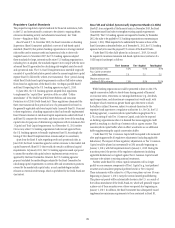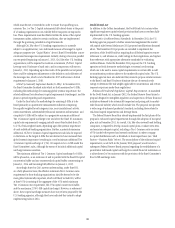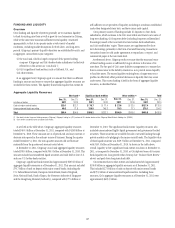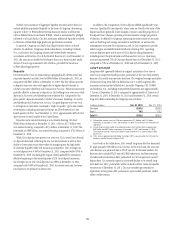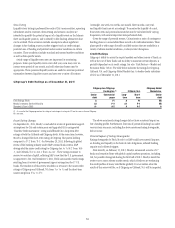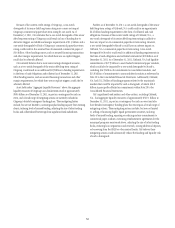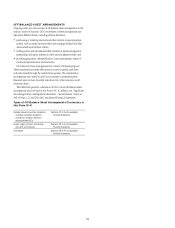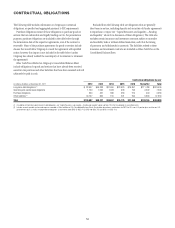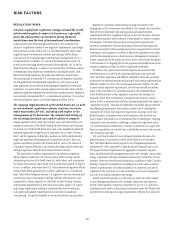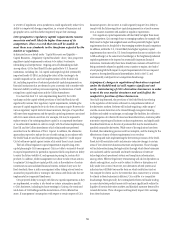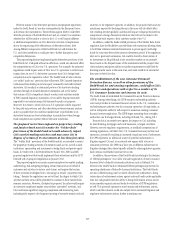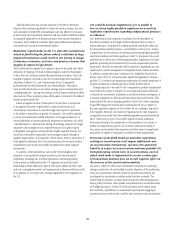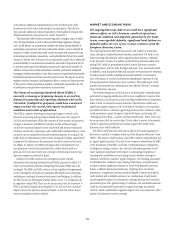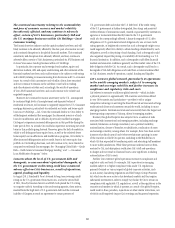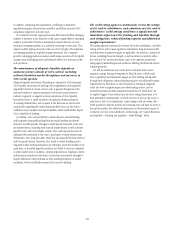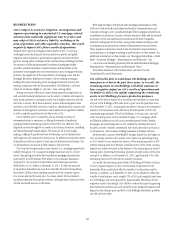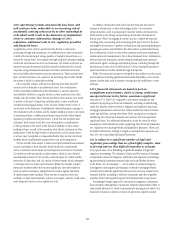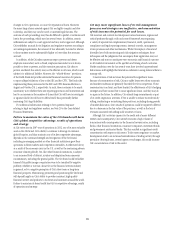Citibank 2011 Annual Report Download - page 77
Download and view the complete annual report
Please find page 77 of the 2011 Citibank annual report below. You can navigate through the pages in the report by either clicking on the pages listed below, or by using the keyword search tool below to find specific information within the annual report.55
RISK FACTORS
REGULATORY RISKS
Citi faces significant regulatory changes around the world
which could negatively impact its businesses, especially
given the unfavorable environment facing financial
institutions and the lack of international coordination.
As discussed in more detail throughout this section, Citi continues to be
subject to a significant number of new regulatory requirements and changes
from numerous sources, both in the U.S. and internationally, which could
negatively impact its businesses, revenues and earnings. These reforms
and proposals are occurring largely simultaneously and generally not on a
coordinated basis. In addition, as a result of the financial crisis in the U.S.,
as well as the continuing adverse economic climate globally, Citi, as well as
other financial institutions, is subject to an increased level of distrust, scrutiny
and skepticism from numerous constituencies, including the public, state,
federal and foreign regulators, the media and within the political arena.
This environment, in which the U.S. and international regulatory initiatives
are being debated and implemented, engenders not only a bias towards
more regulation, but towards the most prescriptive regulation for financial
institutions. As a result of this ongoing negative environment, there could be
additional regulatory requirements beyond those already proposed, adopted or
even currently contemplated by U.S. or international regulators. It is not clear
what the cumulative impact of all of this regulatory reform will be.
The ongoing implementation of the Dodd-Frank Act, as well
as international regulatory reforms, continues to create
much uncertainty for Citi, including with respect to the
management of its businesses, the amount and timing of
the resulting increased costs and its ability to compete.
Despite enactment in July 2010, the complete scope and ultimate form of a
number of provisions of The Dodd-Frank Wall Street Reform and Consumer
Protection Act of 2010 (Dodd-Frank Act), such as the heightened prudential
standards applicable to large financial companies, the so-called “Volcker
Rule” and the regulation of derivatives markets, are still in developmental
stages and significant rulemaking and interpretation remains. Moreover,
agencies and offices created by the Dodd-Frank Act, such as the Bureau of
Consumer Financial Protection, are in their early stages and the extent and
timing of regulatory efforts by these bodies remains to be seen.
This uncertainty is further compounded by the numerous regulatory
efforts underway outside the U.S. Certain of these efforts overlap with the
substantive provisions of the Dodd-Frank Act, while others, such as proposals
for financial transaction and/or bank taxes in particular countries or regions,
do not. In addition, even where these U.S. and international regulatory efforts
overlap, these efforts generally have not been undertaken on a coordinated
basis. Areas where divergence between U.S. regulators and their international
counterparts exists or has begun to develop (whether with respect to scope,
interpretation, timing, approach or otherwise) includes trading, clearing
and reporting requirements for derivatives transactions, higher U.S. capital
and margin requirements relating to uncleared derivatives transactions,
and capital and liquidity requirements that may result in mandatory
“ring-fencing” of capital or liquidity in certain jurisdictions, among others.
Regulatory uncertainty makes future planning with respect to the
management of Citi’s businesses more difficult. For example, the cumulative
effect of the new derivative rules and sequencing of implementation
requirements will have a significant impact on how Citi chooses to structure
its derivatives business and its selection of legal entities in which to conduct
this business. Until these rules are final and interpretive questions are
answered, management’s business planning and proposed pricing for this
business necessarily include assumptions based on proposed rules. Incorrect
assumptions could impede Citi’s ability to effectively implement and comply
with the final requirements in a timely manner. Management’s planning is
further complicated by the continual need to review and evaluate the impact
to the business of an ongoing flow of rule proposals and interpretations from
numerous regulatory bodies, all within compressed timeframes.
In addition, the operational and technological costs associated with
implementation of, as well as the ongoing compliance costs associated
with, all of these regulations will likely be substantial. Given the continued
uncertainty, the ultimate amount and timing of such costs going forward are
difficult to predict. In 2011, Citi invested approximately $1 billion in order
to meet various regulatory requirements, and this amount did not include
many of the costs likely to be incurred pursuant to the implementation
of the Dodd-Frank Act or other regulatory initiatives. For example, the
proposed Volcker Rule contemplates a comprehensive internal controls
system as well as extensive data collection and reporting duties with respect to
“proprietary trading,” and rules for registered swap dealers impose extensive
recordkeeping requirements and business conduct rules for dealing with
customers. All of these costs negatively impact Citi’s earnings. Given Citi’s
global footprint, its implementation and compliance risks and costs are
more complex and could be more substantial than its competitors. Ongoing
compliance with inconsistent, conflicting or duplicative regulations across
U.S. and international jurisdictions, or failure to implement or comply with
these new regulations on a timely basis, could further increase costs or harm
Citi’s reputation generally.
Citi could also be subject to more stringent regulation because of its
global footprint. In accordance with the Dodd-Frank Act, in December
2011 the Federal Reserve Board proposed a set of heightened prudential
standards that will be applicable to large financial companies such as Citi.
The proposal dictates requirements for aggregate counterparty exposure
limits and enhanced risk management processes and oversight, among other
things. Compliance with these standards could result in restrictions on Citi’s
activities. Moreover, other financial institutions, including so-called “shadow
banking” financial intermediaries, providing many of the same or similar
services or products that Citi makes available to its customers, may not be
regulated on the same basis or to the same extent as Citi and consequently
may also have certain competitive advantages.
Finally, uncertainty persists as to the extent to which Citi will be subject
to more stringent regulations than its foreign competitors with respect to
several of the regulatory initiatives, particularly in its non-U.S. operations,
including certain aspects of the proposed restrictions under the Volcker Rule
and derivatives clearing and margin requirements. Differences in substance


